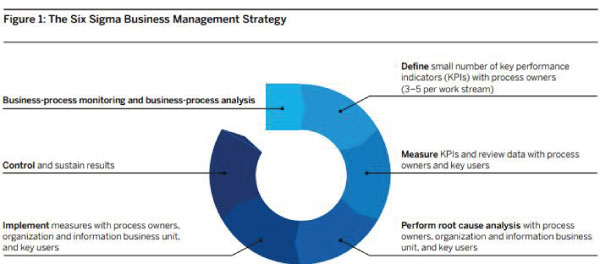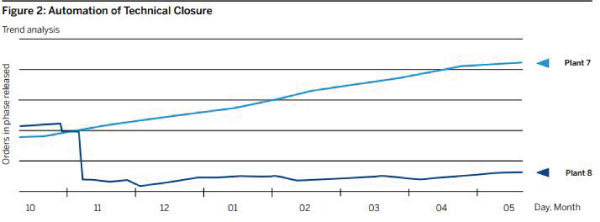Bayer Material Science Innovates with Help from SAP MaxAttention Services
The Business-Process Improvement Experience BMS implemented a company-wide project to transform its business and IT processes. Called ProgramOne (P1), the program’s objective was to define a standard set of global processes and merge the company’s multiple installations of the SAP ERP application into a single global instance to run those global processes. The project provided a single global template for more than 12,000 end users worldwide. The knowledge, applications, and tools of the SAP MaxAttention™ services played a critical role in the project’s success. The business-process analytics functionality of the SAP Solution Manager application management solution has given team members a highly transparent overview of the company’s business processes, showing them how they can leverage the full benefits of what the SAP software environment has to offer. In the words of CIO Kurt De Ruwe: “We are convinced that business-process analytics is the best-kept secret at SAP.”
With the help of the SAP Active Global Support (SAP AGS) organization, the business-process improvement project kicked off in September 2010. An initial analysis of the business processes in the P1 environment, which targets the SAP ERP software environment at BMS, told BMS right away there was potential for improvement. It also revealed to BMS a new issue-oriented approach for measuring process performance. Based on the analysis, BMS decided to pilot two business-process work streams: demand to supply and maintain to settle. The project was an integral part of the BMS process owner community, responsible for seeing that the business processes are sustainable and stable.
Project Objectives The objectives of the project are to simplify, standardize, and automate the business processes at BMS. These key goals are to be achieved by:
- Systematically analyzing the business processes and defining critical milestones within the processes.
- Setting up collectors of business-process analytics data to map critical milestones, for example, to benchmark organizational units or perform an age-structure analysis of backlog documents over the last years.
- Detecting process issues at an early stage by monitoring business processes and sending out alerts when appropriate.
The exceptions that were identified fall into the following main categories:
- Standardization issues
- Systematic end-user failures and end-user training gaps
- Process design gaps
- Master-data issues
- Configuration and customizing needs
Six Sigma Business Management Strategy
The project team at BMS employed the project methodology of the Six Sigma business management strategy referred to as DMAIC; define, measure, analyze, improve, and control. (Please note, the “implement” phase in Figure 1 corresponds to the “improve” phase in the Six Sigma project methodology.) The experiences the team gathered during its project work are summarized here.

Define
During the first phase of the cycle, the team chose the business processes on which the project would focus: the maintain-to settle and demand-to-supply work streams. The team decided which business department or unit it would work with first, gathered requirements, and defined key performance indicators (KPIs) for the work streams. The KPIs were chosen according to business impact, probable benefit, estimated savings, and subprocess lead time.
Measure
The KPIs were measured and evaluated with the business process analytics functionality within the business-process monitoring of SAP Solution Manager. Feedback was incorporated from business-process owners, the community, and colleagues from the Organization and Information (O&I) Service unit responsible for the technical realization of the business processes. This helped the team adjust the setup to reflect more closely the needs of the company and the requirements of the business process itself and included only those process variants relevant to the specific work streams.
Analyze
The team examined the root causes of all deviations from the expected performance detected in the business processes and all exceptions. The business-process analytics functionality generated a list of all backlogged documents, allowing reviewers to jump directly to the affected business document. The colleagues from the O&I Service unit assisted the business departments and business units in checking the documents. The root cause determined for the different deviations and exceptions was often the same. A common cause was process workarounds devised to address business exceptions. Another was identifying further automation potential within the last process steps for maintaining to settle.
Implement
In this phase, business processes were changed and adapted to resolve the root causes of the problems identified, with the project team reinstalling or adjusting business-process designs as needed. For each root cause identified, one or more action items were created, deadlines set, and responsibilities assigned.
Control
In the last phase of the cycle, the team set up monitoring functionality for each business process, defined thresholds, and set up alerts to be sent to the appropriate business person in case of critical deviations. These measures helped stabilize process performance and improve the process efficiency and effectiveness. The reduction of the document backlog was monitored by the trend analysis function within the business process analytics functionality (see Figure 2).

Conclusion
At first, BMS intended to roll out the monitoring and analytics functions for the business processes in a phased approach. However, due to strong interest within BMS and in order to benefit from the adjusted business processes faster, the project rollout now includes three additional work streams (the order to cash, procure-to-pay with accounts payable, and finance to manage processes) as well as the two existing work streams (demand to supply and maintain to settle).
The team is focused as well on increasing awareness within BMS of the tool and the approach taken. BMS has held discussions and encouraged involvement across all work streams, regions, business departments, and business units. The project team will continue to expand the knowledge and further reach out to key users in all areas.
The power of a strong community of joint process owners reinforced by business-process monitoring and business process analytics lies in the transparency, visibility, flexibility, and collaboration achieved through this coordination. With the team (business and O&I) working together, measures to be taken to resolve issues are readily apparent for all team members early on.
“Business-process monitoring and business-process analytics -key tools within SAP Solution Manager- provide a standard, automatic KPI functionality, helping our teams achieve cost-effective leadership, flexibility, and efficiency. Business-process monitoring and business-process analytics are ultimately making us a more efficient and effective business,” emphasizes Laurie Miller, head of O&I Global Support Services at BMS.





